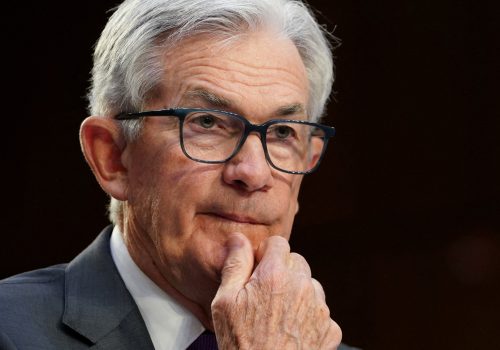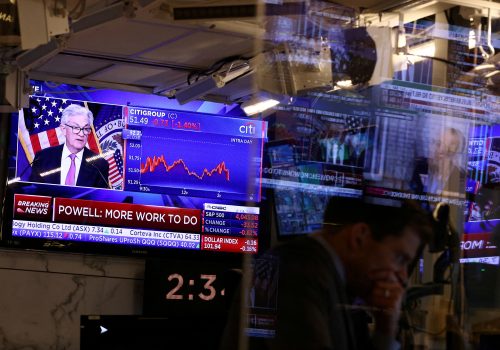Loss of investor confidence and the banking crisis
Despite the best efforts of financial authorities following the most recent banking crisis, selloffs of bank shares and capital contingent bonds have persisted. Prompt actions taken include the Swiss arrangement for the Union Bank of Switzerland (UBS) to buy out Credit Suisse; the US Federal Deposit Insurance Corporation (FDIC) guarantees of uninsured deposits at Silicon Valley Bank (SVB) and Signature Bank; as well as promises to supply liquidity as needed to the banking system. The wide-spread nature of the banking crisis reflects fears among investors of a coming recession in the United States and parts of Europe, crystallizing credit losses—an increasingly likely scenario which current monetary and financial stability policies seem unable to reverse.
After the sale of Credit Suisse, the most poignant example of investor concerns is the market pressure on Deutsche Bank (DB). DB shares have lost more than a fifth of their value this month—despite improving its financial performance in recent years. Following significant restructuring efforts since 2019, DB has posted ten consecutive quarters of profit, including a net income of €5 billion ($5.4 billion) in 2022, a 159 percent increase from 2021. At the end of 2022, its Core Equity Tier 1 capital ratio was at 13.4 percent, Liquidity Coverage Ratio at 142 percent and Net Stable Funding Ratio at 119 percent—all meeting Basel III regulatory requirements.
The satisfactory regulatory ratios for most banks in the US and Europe have enabled financial authorities to insist that their banking system is basically safe and sound. Investors, however, have taken a different view. Since the 2008 global financial crisis, the ratio of market share price to net book value (assets minus liabilities) of European and US banks have traded at half of their pre-2008 averages. Specifically, European banks have traded at around a P/B ratio of 0.6–meaning investors value banks’ net assets at much less than what their financial statements show, reflecting lack of confidence in the profitability of those banks. By comparison, the P/B ratio of US banks has been around 1.4.
In short, the turmoil in the banking sector of global equity markets reflects the lack of confidence that banks can cope with the current and expected difficult business environment. Most worrisome is a likely recession that would cause losses in banks’ loan and credit portfolios.
Besides interest rate risks, which have materialized due to quickly rising interest rates, credit risk is the second shoe to drop. Some economists have looked for this event to assess the severity of what increasingly appears to be a systemic financial crisis. Financial regulators have identified several areas of vulnerability that can crystallize into losses: commercial real estate, construction loans, and leveraged loans packaged into Collateral Loan Obligations. Those financial products have been distributed widely beyond the banking sector— to pension funds, insurance companies, and investment funds. Some investment funds are vulnerable to redemption runs by their investors, thus bearing similar risks as SVB and Signature Bank of asset losses combined with unstable funding.
Unfortunately, under current unsettled financial conditions, monetary policy and financial stability policy as articulated by authorities have failed to reassure market participants. At times, they even seem to have the opposite effect.
Major central banks, most notably the Federal Reserve System and the European Central Bank, have continued to tighten. However, the Fed has done so by less than it planned to, and the tightening has been accompanied by changes in rhetoric. The words “ongoing increase” became “some additional firming” in the recent Federal Open Market Committee statement. The banks have also indicated that they are prepared to raise rates further if inflation remains stubbornly high. The message sent to financial markets implies that, as a last resort, central banks are prepared to accept a recession to bring inflation under control. Consequently, market participants must price this possible outcome, focusing on the weak link—being banks and, eventually, other non-banking financial institutions.
Central banks have also emphasized that they will closely monitor financial market instability and stand ready to supply liquidity as needed. However, in the case of the United States, tension is revealed in the changes in Treasury Secretary Janet Yellen’s recent remarks. On March 22, 2023, she said she had not considered blanket insurance to all deposits (as requested by a group of mid-sized banks) without congressional approval. The following day, Yellen said she was prepared to stabilize banks and ensure the safety of their deposits. Amid growing political opposition to what is perceived to be bailouts of large depositors of the two failed banks, there is uncertainty about whether and to what extent the US Department of the Treasury and regulators can protect all bank deposits without congressional approval. This is especially difficult to predict given political divisiveness in the United States.
More importantly, supplying liquidity, while useful, may not be sufficient to quell the current market turmoil. This is despite the simplistic belief that authorities have a set of policy tools to deal with financial crises, separate from interest rate policy. Specifically, the problems facing banks are not necessarily liquidity or solvency weaknesses, but due to investor loss of confidence. Many banks—like DB—have maintained adequate capital and liquidity positions, but still came under market pressure when their investors lost confidence in their ability to navigate the difficult period ahead. Unfortunately, the authorities have amplified this fear by raising the risk of a recession and its attendant credit losses.
At this juncture, it is important for central banks to recognize that combating inflation is important in the medium term, while averting a full-blown global financial crisis is an acute problem which should be prioritized now. Central banks should do everything they can, including becoming more flexible in their interest rate decisions to calm down equity markets, especially for banks. At the same time, they should communicate their commitment to bring inflation under control over time.
This is a tall order for central banks and authorities to rise to in today’s politically polarized circumstances. But the stakes are much higher for everyone. There is a greater risk of losses of output, employment, and wealth in a recession accompanied by a banking crisis.
Hung Tran is a nonresident senior fellow at the Atlantic Council; a former executive managing director at the Institute of International Finance and former deputy director at the International Monetary Fund.

At the intersection of economics, finance, and foreign policy, the GeoEconomics Center is a translation hub with the goal of helping shape a better global economic future.
Further reading
Mon, Mar 20, 2023
Central bankers must keep financial stability in mind as they fight inflation
New Atlanticist By Hung Tran
It is difficult for central banks to balance controlling inflation with preserving financial stability amid a banking crisis, but that is no excuse not to try.
Wed, Mar 15, 2023
Bailouts create a moral hazard even if they are justified. Is there another way?
New Atlanticist By Hung Tran
The US guarantee for Silicon Valley Bank and possible Swiss intervention for Credit Suisse raise important questions. Here's one alternative approach for large depositors.
Thu, Mar 16, 2023
It’s not 2008: Keep calm as central banks carry on
New Atlanticist By Josh Lipsky
This week's financial drama may look familiar, but the world's financial firefighters have been preparing for this moment for nearly fifteen years.
Image: Deutsche Bank branch in Hamburg. Deutsche Bank is one of largest banks in the world with 98,200 employees (2013).


